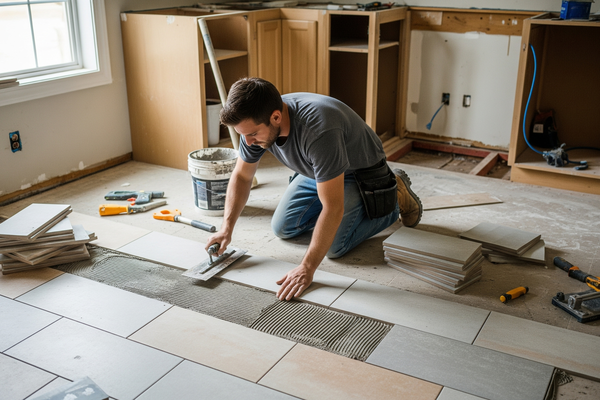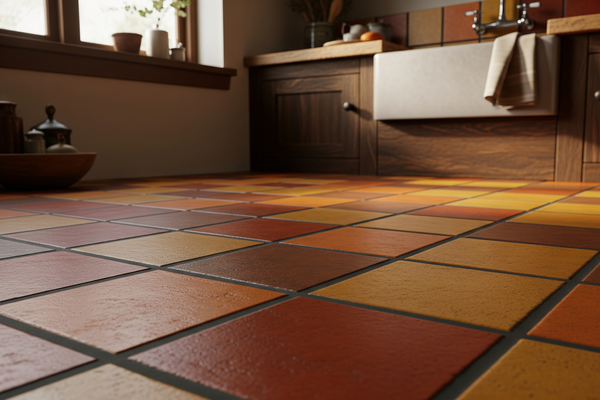The most popular way to lay subway tile is the classic running bond pattern, which features tiles arranged in an offset, staggered layout that's both timeless and easy to install. However, subway tiles offer far more versatility than this traditional approach.
Subway tiles are rectangular ceramic tiles that have become the go-to choice for kitchen backsplashes due to their affordability, durability, and design flexibility. Originally used in New York City Subway tiles in the early 1900s, these tiles now dominate modern kitchen design trends.
Key benefits of subway tiles in kitchens include:
- Cost-effective and budget-friendly solution
- Easy maintenance with nonporous surfaces, stain-resistant surfaces
- Compatible with any kitchen style from traditional to contemporary
- Available in multiple colors, finishes, and installation patterns
This comprehensive guide covers 13 proven subway tile installation methods that can transform any kitchen space, from small galley kitchens to expansive cooking areas. Whether you're planning a DIY project or working with contractors, these patterns range from beginner-friendly laying tile layouts to advanced decorative techniques.
Installation difficulty varies by pattern: Simple running bond and stacked layouts require basic tiling skills, while herringbone, chevron, and basketweave patterns demand more precision and cutting expertise. Professional installation ensures optimal results and long-lasting durability.
Ready to discover which subway tile pattern will best enhance your kitchen's functionality and aesthetic appeal?

13 Outstanding Concepts for Kitchen Renovation with Subway Tiles
Below you'll discover exceptional methods for incorporating subway tiles into kitchen designs that will certainly enhance the appeal of even the most ordinary cooking spaces.
1. Traditional Staggered Pattern
The most efficient method for enhancing kitchen attractiveness involves implementing a traditional offset arrangement through classic running bond techniques. This subway/metro tile kitchen backsplash proves simpler to install compared to alternative patterns while demanding minimal complex tile cutting. When applying running bond subway tiles, joints become offset and positioned at the center point of surrounding tiles. This approach contributes just the right degree of contemporary style to any welcoming space.
2. Upright Staggered Layout
Vertically positioned subway tiles in kitchens create an illusion of elevated walls and ceiling height. Kitchen subway tiles produce a bold and unexpected visual impact when arranged in running bond formations and paired with charcoal or blackgrout lines. Tiles installed in vertical orientation guide the eye in an upward direction. This technique proves particularly effective in confined spaces. It can generate the perception of increased height in compact rooms, making the entire area feel more spacious. Consequently, spaces with lower ceiling heights can appear more expansive.
3. Explore a Chevron Design
The herringbone arrangement represents one of the most eye-catching subway tile kitchen configurations. The slender and elongated tiles in this design create the distinctive zigzag visual effect. Herringbone subway tile installations serve as excellent backdrops for kitchens featuring a classic or retro aesthetic. A herringbone layout can echo the linear elements found throughout a kitchen space. To establish a subtle contrast backdrop that allows other design elements to shine, select grout colors that closely match your tile selection from our tiles by color collection.
4. Embrace Vibrant Hues
The vibrant blue kitchen by Design Mix demonstrates that subway tile kitchens can complement any color palette effectively. The navy cabinetry paired with dark grout lines delivers contemporary design appeal and unique character while maintaining sophistication. Kitchens featuring colorful and bold subway tiles offer durability, effortless maintenance, and easy cleaning; marks and spots become less noticeable and can be readily wiped away. Since colored tiles feature nonporous surfaces, they resist mold and mildew accumulation. For additional inspiration, explore comprehensive kitchen upgrade ideas.

5. Contemporary Rustic Style
A cozy and inviting ambiance emerges through rustic subway tile kitchens, featuring complete backsplashes and vintage-influenced accents. These rustic subway tiles possess a distinctive aged charm, living up to their designation. The surface texture makes them nearly indistinguishable from weathered materials, with the aging effects contributing positively to the overall appeal. Within kitchen spaces, rustic tiles function excellently as backsplash elements or counter surfaces and will complement European interior designs or old-world design themes beautifully. This style perfectly captures the essence of vintage kitchens with modern functionality.
6. Linear Stacked Layout
The horizontal stacked subway tile arrangement in kitchens effectively creates a more expansive feel. The stacking bond design ranks among the most straightforward patterns for subway tile installation. A space featuring this minimalist pattern gains an surprisingly contemporary edge and organized aesthetic that seamlessly matches transitional and modern design approaches. Kitchen backsplashes using horizontal subway tiles positioned in this configuration fade into the background, showcasing attractive appliances. This specific layout makes the area appear visually open, wider, and larger in overall dimensions. Visit Our Showroom to see these patterns in person.
7. Dual Basket Weave Pattern
The basket weave subway tile backsplash configuration in kitchens provides a modern interpretation of a timeless design. This subway tile arrangement proves straightforward to plan and execute, featuring paired vertical tiles encircled by paired horizontal tiles. It represents an economical method for producing dramatic accent walls since it utilizes commonly available tile dimensions and shapes. Dark grout fills the narrow spaces between these tiles, gently outlining the three-dimensional design.
8. Full-Coverage Tiling for Unified Appearance
Adopt the full-coverage tiling movement by enveloping complete walls or your entire kitchen space with subway tiles. This method establishes a harmonious and consistent appearance that can deliver striking visual impact in your cooking area. Think about applying kitchen subway tiles from ground level to ceiling height for maximum dramatic results. The effect becomes more powerful when you extend coverage across all four walls, establishing a continuous foundation for your kitchen design. Discover various options in our tile types section.
9. Enhance Your Storage Area with Kitchen Subway Tiles
Convert your storage area into an elegant and practical environment by applying subway tiles to the wall surfaces. Subway tiles will not only introduce texture and visual appeal to the pantry space but also enhance its overall attractiveness. This approach establishes design consistency throughout the entire kitchen area. Select traditional white subway tiles for optimal outcomes, as light-toned tiles represent the ideal selection for these particular installations.
10. Combine Different Layouts for Enhanced Visual Appeal
Move beyond conventional brick arrangements and explore various tile configurations to introduce visual intrigue to your cooking space. Think about positioning subway kitchen tiles in herringbone, zigzag, or woven patterns to achieve a distinctive and captivating appearance. Blend and coordinate different tile arrangements to develop a personalized design that showcases your individual taste and elevates the complete visual appeal of your kitchen. Browse our tile stylescollection for inspiration.
11. Extend to the Ceiling with Subway Tiles
Carry subway tiles upward to the ceiling to establish a compelling centerpiece in your cooking area. This technique makes the room appear more spacious and open. Think about applying subway tiles to the overhead surface above your kitchen workspace or around the room's edges for a bold and distinctive accent. Consider our large format subway tile options for dramatic ceiling applications.
12. Combine Mosaic Tiles with Subway Tiles
Unleash your creativity with backsplash designs by developing a mosaic arrangement. Incorporating subway tiles alongside mosaic tiles allows you to introduce striking visual elements to your area. Experiment with various configurations to establish a distinctive character. A mosaic backsplash contributes dimension and surface variation to the kitchen while providing an outlet for artistic expression. Learn more about 3D design principles to maximize visual impact, and explore our 3D decorative subway tile collection. For additional texture options, Shop Mosaic Tiles in our main collection.
13. Surround Your Windows With Subway Tiles
Accentuate your kitchen windows by encasing them with subway tiles to achieve a refined and unified appearance. Apply subway tiles around the window's border to establish a neat and completed edge. Additionally, you can develop an ornamental trim using contrasting tiles or an alternative tile arrangement. This technique can introduce architectural appeal to the cooking space. For precise measurements, check our your perfect size guide.
Conclusion
Subway tiles offer endless possibilities for transforming your kitchen into a stylish and functional space. From classic running bond patterns to bold herringbone designs, these versatile tiles can adapt to any aesthetic preference while maintaining their timeless appeal. Whether you choose to embrace vibrant colors, extend tiles to the ceiling, or combine different patterns for visual interest, subway tiles provide an affordable yet impactful solution for kitchen renovation.
The beauty of subway tiles lies in their ability to complement both traditional and contemporary designs while offering practical benefits such as easy maintenance and durability, especially when paired with quality kitchen countertop materials. By implementing any of these 13 creative ideas, you can create a kitchen that reflects your personal style while adding lasting value to your home. Remember that the key to successful subway tile installation is choosing the right pattern, color, and grout combination that harmonizes with your overall kitchen design vision. For expert guidance, contact our design experts or explore our product collection at Nova Tile & Stone Homepage.
Frequently Asked Questions
What is the most popular subway tile pattern for kitchens?
The classic running bond (offset pattern) remains the most popular choice for kitchen subway tiles. This traditional staggered layout is easy to install, requires minimal complex cutting, and creates a timeless look that complements various kitchen styles while adding modern appeal to any space. Consider our 3x12 matte porcelain subway tile for this classic pattern.
Should I use light or dark grout with subway tiles?
The grout color choice depends on your desired effect. Light-colored grout creates a seamless, cohesive appearance, while dark grout provides contrast and emphasizes the tile pattern. For herringbone or basketweave patterns, choose grout that closely matches the tile color to create a subtle background that highlights other kitchen features.
Can subway tiles make a small kitchen appear larger?
Yes, subway tiles can create the illusion of a larger space when installed strategically. Vertical installations draw the eye upward, making ceilings appear higher, while horizontal stacked patterns make rooms feel wider. Light-colored tiles and extending coverage from floor to ceiling can further enhance the spacious feeling.
Are colorful subway tiles practical for kitchen use?
Colorful subway tiles are highly practical for kitchens as they are durable, easy to maintain, and simple to clean. Their nonporous surface resists stains, smears, mold, and mildew. Additionally, colorful tiles help hide minor stains and marks better than pure white tiles, making them ideal for busy cooking spaces. Browse our glossy subway tile options for easy-to-clean surfaces.
How high should I install subway tile backsplashes in my kitchen?
The height of your subway tile backsplash depends on your design goals and kitchen layout. Standard backsplashes typically extend 4 inches above countertops, but for maximum impact, consider installing tiles from countertop to ceiling or covering all four walls. Full-height installations create dramatic effects and establish seamless backdrops for kitchen appliances and cabinetry.